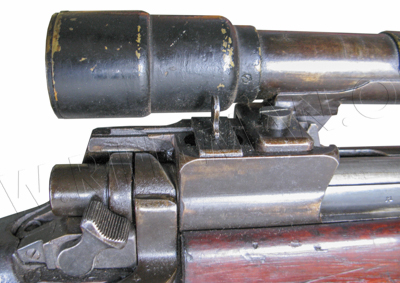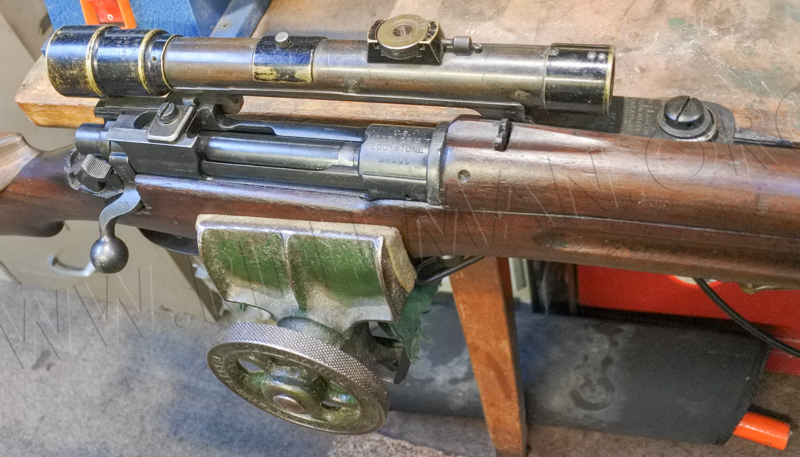Pattern 1917 Enfield .30-06 calibre Sniper Rifle
See also: the .22 rimfire training versions of the P'14 and P'17 rifles
Plus: the Soley Armaments Co. Experimental SMLE-style conversion of the Enfield No.3 (Pattern '14) Rifle
and the preceding Pattern 1913 Trials Rifle.
This page's rifle is an extremely unusual Model of 1917 30-06 calibre rifle, of Enfield 1914 design, that followed on from Pattern '14 Enfield designed rifles of .303 inch calibre that were manufactured in the United States of America early in the First World War, under contract to and for the British War Department - at a time when Great Britain's manufacturing capacity was already at full stretch producing the S.M.L.E. rifle (Short Magazine Lee-Enfield) in addition to a plethora of other weaponry and equipments.
As the United States entered WWI they produce their own version of the rifle in the then current American military .30-06 inch calibre. Both the P'14 and P'17 rifles were produced mainly by three well-known U.S. manufacturers; Winchester, Remington and Eddistone.
Most rifles that were fitted with telescopic sights in the U.K were selected from Winchester production.
In the U.K. the P'14 rifle was afforded the nomenclature Enfield Rifle No.3, and the over-bore 1918 telescope fitted arm became the Rifle No.3(T) Mk.I*, often just described as the No.3T for short.
Necessarily, on occasion, a letter was suffixed to denote other types of telescope and mount fitment; e.g. No.3T(A) Mk.1 for our example rifle with the side-mounted telescope.
Technically obsolete post the Great War, large numbers of these rifles were put into emergency storage, and were to prove their worth twenty years later with the onset of World War Two in 1939.
The serious threat of invasion in 1940 led to the formation of the Local Defence Volunteers, subsequently morphing into the Home Guard. With the majority of the then still current S.M.L.E. rifles, and the fairly new No.4 rifles, committed to troops within Europe, and the subsequent loss of huge numbers of weapons during the Dunkirk evacuation,the P'14, and P'17 rifles were issued to Home Guard units country wide.
Early in WW1, S.M.L.E. rifles were fitted with target rifle sights to assist with more accurate sharpshooting,work often undertaken by experienced pre-war target shooters who had joined up. Lee-Enfields were fitted with Galilean type sights, which comprised a low magnification objective lens fitted to the nose-cap, and a correcting eye-piece lens attached to the tangent rear-sight - such as the Lattey sights, or in place of the rear volley-sight aperture arm - such as the Gibbs arrangement.
What sets our example rifle apart from the run-of-the-mill No.3T model based on the .303" P'14, is that it is a conversion of a P'17 Model .30-06 of Eddistone manufacture.
Here is an opportunity to view every aspect of the rifle.
The next two images can be rotated and zoomed, either as initially loaded or full-screen for higher definition.
Slide cursor < > to rotate, and Click to zoom.
The upper image shows rifle rotating in the horizontal plane.
The lower image shows it rotating around the bore axis.
Sadly it was, as recently as 2006, deactivated; but nevertheless has a near uniqueness in its configuration.
It had, at some time, undergone the work to prepare it for the fitment of a side-mounted telescope
of the type designed and produced by the Alex Martin Company in WWI.
The sight-protecting wings had been machined off, affording a flat at the rear of the action to take the telescope's rear mount.
The main reason for side mounting a telescope, when sniping rifles were being introduced early in the Great War,
was to retain the ability to reload the rifle using its cartridge clips, which action was precluded by the over-bore fitment of a 'scope.
It was believed that the user of the rifle should still be able to quickly reload, and fire rapidly, in the event of an onrushing attack.
The way in which snipers generally had to operate from remote covered positions eventually led to the understanding that the
convenience and practicality of over-bore telescopes outweighed the need to retain clip loading,
and the days of the side-mounted 'scope were numbered.
However, during much of the war it was a case of "needs must when the devil drives" and,
with the supposed need to retain fast reloading, the removal of the original rear-sight posed an obvious problem.
An alternate open iron rear-sight was required for such emergency use.
The usual arrangement for this was as designed and fitted to the .303" No.3T rifles.

Illustrative image of this side-mount converted P'14 .303 rifle
is by kind permission of the Warminster Small Arms School Collection
A free-standing battle aperture was made up of a small rectangular base-plate with a flat sheet upstanding ring with an aperture.
This was fitted across the milled flat original rear-sight protector wings,
with a pair of fixing screws, immediately behind the telescope's own rear mount base-plate,
with an open over-bore sight-line immediately beside the telescope.
This P'17 rifle has a highly unusual, more robust and cleverly engineered "U"-notched rear-sight block
that has been dovetailed into the barrel's reinforce approximately an inch ahead of the action.

Its positioning has necessitated the cutting of an oblong athwartships slot in the rear handguard wood,
through which the top of the rear-sight block protrudes. A very neat arrangement that we have seen nowhere before.
Should you know anything of this type of conversion, we would be most grateful to hear of it.
When it entered our collection in 2014, the rifle was without telescope.
Indeed, although the major work of the conversion had been completed, it was evident that a 'scope had never been fitted,
as the 0BA holes in the action for the rear mount fixing screws had not beendrilled and tapped.
There was only a 4BA threaded hole in the top of the action in the correct position for the vertical fastening.
Our store held an original Pattern 1916 Aldis telescope on the correct Alex Martin mount,
and it seemed a matter of fate that the rifle and 'scope should be reunited; as indeed they were quite recently.
All that we can presently surmise of the rifle's origin comes from the few clues showing, some of which may be misleading.
The stocking has few markings, which amount to the right-hand-side of the butt showing the stamp "E.O.T.C.",
suggesting a sometime holding in an Officers' Training Corps.
There is also a small Canadian "Broad Arrow" stamp close-by the above mark, consisting of the usual vertical arrow within a "C".
One confusing aspect of the furniture markings, is that the fore-end front face,
within the nose-cap ironwork, carries a faint large "W" stamping.
That an Eddistone barrelled action may be wearing a Winchester overcoat is odd, to say the least,
but much may have happened within the more than a hundred year lifetime of such a weapon.
The upper hanguards and the main stock appear to match well,
and the rear handguard's modification to accommodate the 'emergency' rear-sight
suggests that all the furniture was there at the time of the conversion.
A search for the unit to which "E.O.T.C." may have referred has brought up a limited number of options.
However, whether that unit held the rifle in its originally issued configuration, during its time of conversion, or latterly has yet to be discovered.
As an American rifle, it may have been connected with the WWI Virginian based "Engineering Officers' Training Corps" in the past.
The rifle's ironwork carries the U.S. "Flaming Bomb" stamping in several places, as used on rifles brought to the U.K. and Europe during the Great War,
but the likelihood of a telescopic conversion of a British design within the U.S.A. at that time seems to be small.
A conversion made in Europe or Britain between 1917 and the end of the War, wouldperhaps have been more likely,
but not certain, to have been completed with fitment of the telescope, rather than left unfinished.
A third possibility involves theBritish Home Guard in WWII.
Had the rifle been issued to a H.G. unit, and a member have held an Alex Martin mounted type telescope left over a s WWI War Surplus,
the resourcefulness, inventiveness, and needs of the day would certainly have seen such a project as this conversion embarked upon.
If this was started late during the period of the invasion threat,
the rapid and welcome reduction of that threat may have seen such a project shelved.
This is all supposition on our part, with little foundation on evidence,
so we are seeking any help with this puzzle that our readers may be able to offer.
Please feel free to use the contact links at the top and bottom of this page if you feel you may hold constructive information.
__________________
Below: the appropriate section of the 1945 Parts Identification List for the sister .303 P'14 Enfield No.3 military and 3T sniping rifle, with drawings.
However, the P'14 WWII version used the Aldis Pattern 1918 telescope fitted to over-bore mounts, rather than the WWI side-mounted configuration of this page's example rifle.
We have deliberateley not described this rifle as a No.3T of any type, as that would be highly questionable.
The document is illustrated in the form of a text-searchable flip-page booklet.
And another flip-page document of the Enfield Royal Small Arms Factory Rifle No.3T Drawings
Or the Enfield drawings are available HERE
See also: the .22 rimfire training versions of the P'14 and P'17 rifles
Plus: the Soley Armaments Co. Experimental SMLE-style conversion of the Enfield No.3 (Pattern '14) Rifle
and the preceding Pattern 1913 Trials Rifle.
Also read a fascinating contemporary insight into the birth of the .30-06 calibre 'American Enfield' Pattern '17 Rifle
Click here for Chronology of Enfield genre Training Rifles, Adapters & Cartridges
Return to: TOP of PAGE
See this website's Raison d'être

